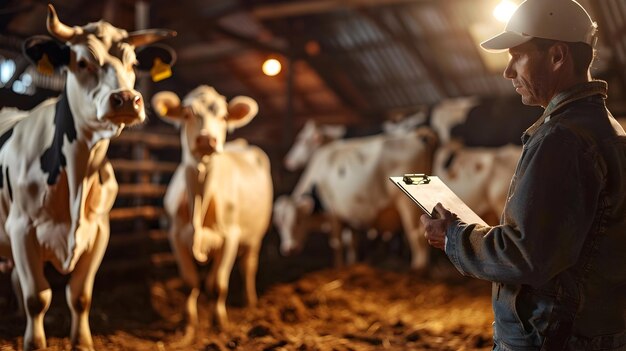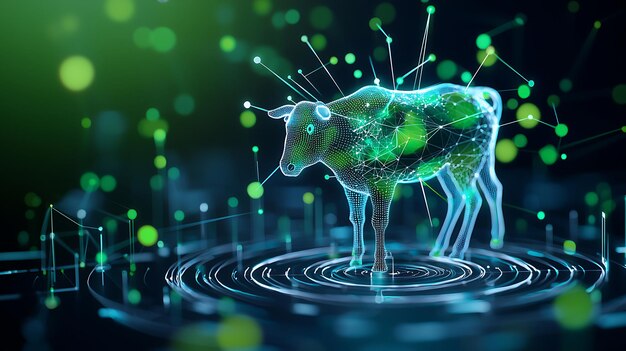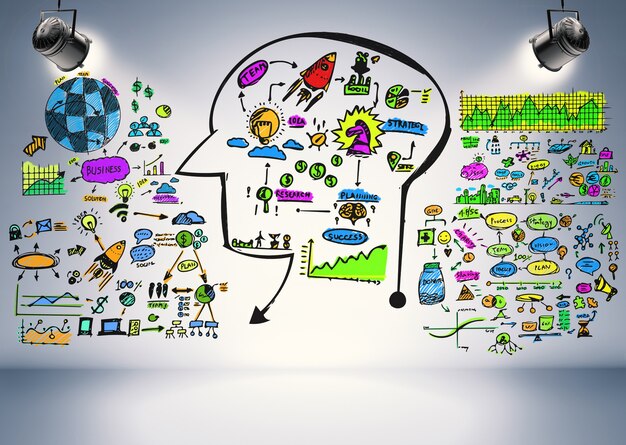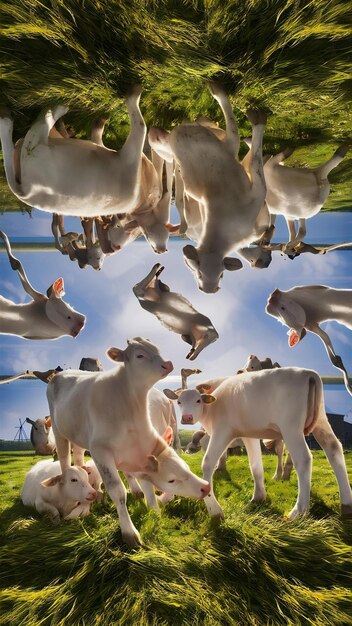The Hidden Intelligence of Cows: Unraveling the Myth
Cows, often perceived as simple and docile creatures, have been subject to numerous myths throughout history. However, recent scientific discoveries are shedding new light on their true intelligence level. Myth No. 1: Cows have an average brain the size of a walnut. In reality, a cow’s brain is larger than that, being comparable to the human brain in certain aspects.
Hidden Emotional Capacities
Contrary to popular belief, cows are not mere machines for milk production. They possess advanced emotional and social skills. For instance, they form deep friendships with other cows and remember them for their entire lives. They also display maternal love, caring for their calves, and have been observed to grieve when a herd member passes away.
Communicative Abilities
Cows communicate effectively using a complex system of sounds and body language. They have individual vocalizations for different situations, such as warning calls for danger or greeting calls when reunited with their group after calving. These behaviors suggest a level of intelligence that far surpasses the stereotypical image of cows as unintelligent animals.
Learning and Memory
Cows are also capable learners. They can remember locations, such as water sources or feeding areas, for long periods. Furthermore, they display problem-solving skills when faced with complex tasks, like opening gates using their heads to push them open.
Intelligence and Welfare
Understanding the true intelligence of cows has significant implications for their welfare. Keeping this in mind, modern farming practices are starting to focus more on creating enriched environments for these animals. This includes providing opportunities for social interaction, allowing natural behaviors, and minimizing stress.
Conclusion
The hidden intelligence of cows is being unveiled through scientific research. They are emotional beings with advanced social skills, capable communicators, and learners. It’s time to debunk the myths surrounding cows and recognize them for the complex creatures they truly are.

Unlocking the Hidden Intelligence of Cows: Challenging Preconceived Notions
Cows, often perceived as unintelligent and docile animals, have long been the subject of
stereotypical portrayals
in media and literature. Their role is typically limited to providing milk, meat, or labor, with little regard for their cognitive abilities. However, challenging this perception is not only essential for advocating for better treatment and understanding of these animals but also for recognizing the potential
benefits
of acknowledging cow intelligence.
In recent years, numerous studies have begun to reveal the
complex cognitive abilities
of cows. For instance, they can remember faces and voices for several years, exhibit problem-solving skills, and even display emotional intelligence. Yet, these findings often go unnoticed due to the deeply ingrained belief of their
lack of intelligence
. This myth not only affects how we treat cows but also overlooks the opportunities to further explore their capacities and improve their living conditions.
The
objective of this paper
is to explore the hidden intelligence of cows and challenge prevalent myths. By highlighting the latest research findings and shedding light on the intricacies of cow behavior, we aim to encourage a shift in perception and promote better understanding and respect for these remarkable animals.
Stay tuned as we delve deeper into the fascinating world of cow intelligence and uncover the many ways in which these animals are far more intelligent than most give them credit for.
#CowIntelligence #AnimalBehavior #MooPoint

Background on Cow Intelligence Research
Cow intelligence and behavior have been subjects of scientific inquiry for several decades, with early studies emerging in the mid-20th century.
Brief history of research into cow cognition and behavior
The roots of cow cognition research trace back to the 1950s and 1960s when ethologists began studying their social structures, communication systems, and emotional lives. These pioneering researchers, such as J. Armitage and G. L. Hester, recognized the importance of understanding the complex behaviors exhibited by these animals. However, it was not until more recent times that advancements in ethology, animal psychology, and neuroscience allowed for a deeper exploration of cow intelligence.
Early studies in the mid-20th century
Initial research on cow intelligence focused primarily on observational methods, documenting their social behaviors and communication patterns. Researchers like M. S. Fox began to explore the cognitive abilities of cattle, investigating their memory and problem-solving skills through simple tasks such as maze navigation.
Recent advancements in ethology, animal psychology, and neuroscience
With the advent of more sophisticated research techniques, recent years have seen significant progress in our understanding of cow intelligence. Neuroscientific studies have shown that cows possess a complex neural system with regions specialized for processing spatial information, memory, and emotions. This research has shed light on their ability to learn from experience, remember faces, and develop emotional bonds.
Importance of understanding cow intelligence
Animal welfare: Understanding cow intelligence is essential for ensuring their well-being, both in natural and farming contexts. Knowledge about their cognitive abilities and emotional lives allows us to improve living conditions, reduce stressors, and minimize suffering.
Agriculture: By understanding the cognitive abilities of cattle, farmers can optimize production and management practices. For instance, they may design more efficient feeding systems based on cow memory and problem-solving skills or utilize their social tendencies to improve herd cohesion.
Human-animal interaction: Insights into cow intelligence also have implications for human-animal interactions. By recognizing the emotional lives and cognitive abilities of cows, we can build stronger bonds based on mutual respect and understanding.

I Cow Cognitive Abilities
Cows are known for their remarkable cognitive abilities that go beyond simple reflex actions. Let’s explore some of these capabilities in detail.
Memory and problem solving
Recognition memory: Long-term and short-term memory studies
Cows exhibit both long-term and short-term memory. Spatial memory is a long-term memory aspect, as evidenced by their ability to navigate mazes. For instance, in a study, cows were trained to find food hidden at specific locations in a complex maze. After several days, they could remember the location of the hidden feed and quickly found it upon reintroduction to the maze.
Short-term memory comes into play during problem solving through lateral thinking. For example, in an experiment, cows were presented with a problem where they needed to press a pedal with their snout to obtain food. However, the platform was too high for them to reach initially. They eventually figured out how to use a nearby bucket to stand on, demonstrating their ability to learn and apply problem-solving skills.
Problem solving through lateral thinking: Examples from various experiments
Moreover, cows have shown impressive problem-solving skills in other experiments. One study involved placing a food reward inside an opaque container, which was suspended above the cow’s reach. The cow, after attempting various methods like using its horns and head to move the container, finally learned to use a nearby trough filled with water as a stepping stool to reach the reward.
Communication and social behavior
Vocalizations, body language, and facial expressions
Cows communicate using a range of vocalizations, body language, and facial expressions. They use different mooing sounds to signal distress, contentment, or even greet other cows. Their body language like ear position, tail movement, and head shaking also convey various emotions. Facial expressions such as winking are observed in cows to signify submission or friendliness.
Group dynamics and social structure: Herds, families, and dominance hierarchies
Cows live in groups called herds, which consist of several females along with their calves and a dominant male. They form strong social bonds within the group and exhibit complex hierarchical structures. The herd functions as a single unit, with each cow assuming specific roles based on her age, reproductive status, and individual characteristics.
Emotional intelligence
Ability to recognize and respond to human emotions: Empathy and fear in cows
Cows are capable of recognizing human emotions. For instance, they can distinguish between angry and happy faces and respond accordingly. They show empathy towards their calves and other cows in distress, displaying protective behaviors.
Emotion regulation: Coping mechanisms and stress reduction techniques
Moreover, cows have developed various coping mechanisms to regulate their emotions and reduce stress. For example, they engage in social grooming with other cows, which helps them maintain social bonds and relieve anxiety. They also exhibit repetitive behaviors like paw-licking or cud-chewing when stressed, providing self-soothing comfort.

Cow Social Intelligence
Cows are known for their strong social skills and intelligence, which play a vital role in their well-being and survival. Let’s explore some aspects of cow social intelligence.
Social Learning through Observation and Imitation
Imitation of Human Actions:
Cows exhibit remarkable abilities to learn from humans through observation and imitation. For instance, they can milk themselves when they see the milking process or even learn to open gates if shown how. Similarly, they can feed themselves by pushing bales or pressing levers in automated feeders after observing humans doing it a few times.
Learning from Other Cows: Socialization, Education, and Transmission of Knowledge
Cows learn various social skills from other cows. For example, calves observe their mothers and other cows to learn how to graze, drink water, and form a herd. Younger cows also learn social behaviors like grooming and mating from older cows in the herd. This socialization, education, and transmission of knowledge help maintain a harmonious herd life.
Recognition and Discrimination of Individuals and Groups
Cattle Breed Identification:
Cows have excellent recognition and memory skills, which help them distinguish between different cattle breeds, even if they are not physically present in the herd. This ability enables cows to recognize potential predators or competitors based on their appearance and behavior, contributing to herd safety.
Human-Animal Bonding: Individual Preferences, Attachment, and Bonding
Cows form strong bonds with humans and other cows. They can recognize individual humans and remember them for years. For instance, they may prefer to be milked by a specific person due to their attachment or association with positive experiences.
Cooperation and Altruism among Cows
Mutual Grooming, Nursing, and Caretaking:
Cows display cooperative behaviors like mutual grooming, nursing, and caretaking. They lick and groom each other to maintain social bonds and keep their coats clean. Older cows often nurse younger calves that are rejected by their mothers or have lost theirs.
Herd Protection and Warning Signals:
Cows work together to protect their herd from predators by forming a circle around the young or weak members and giving warning signals like lowing, snorting, or stampeding in response to potential threats.

